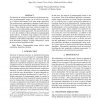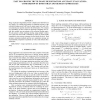1127 search results - page 1 / 226 » Comparison of registration methods using mamographic images |
84
Voted
ICIP
2010
IEEE
14 years 10 months ago
2010
IEEE
The detection of architectural distortions and abnormal structures in mammographic images can be based on the analysis of bilateral and temporal cases using image registration. Th...
IVC
2006
15 years 20 days ago
2006
The aim of medical image registration is to bring different images into the best possible spatial correspondence in order to obtain complementary information for clinical applicat...
117
Voted
ISBI
2011
IEEE
14 years 4 months ago
2011
IEEE
Myocardial tagging in magnetic resonance imaging (MRI) has shown great potential for noninvasive measurement of the motion of a beating heart. A critical issue in exploiting this ...
113
click to vote
IPMI
2007
Springer
16 years 1 months ago
2007
Springer
Volumetric registration of brains is required for inter-subject studies of functional and anatomical data. Intensity-driven registration typically results in some degree of misalig...
ISBI
2008
IEEE
16 years 1 months ago
2008
IEEE
Image registration algorithms provide a displacement field between two images. We consider the problem of estimating accuracy of the calculated displacement field from the input i...


